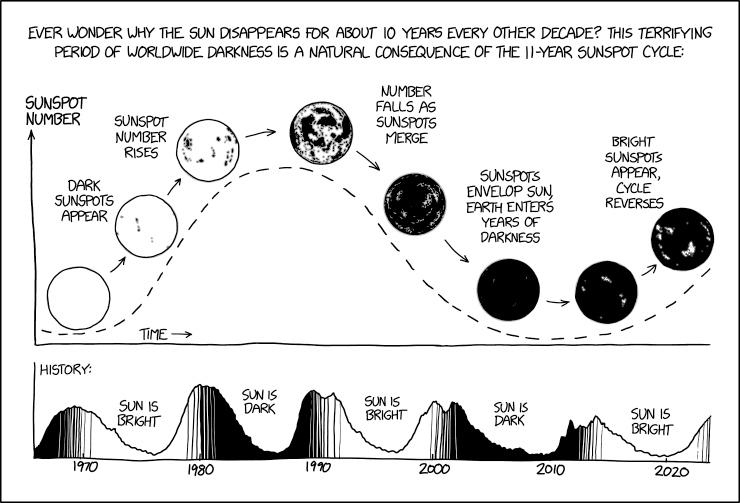Sunspot Cycle

Who can forget the early 2010s memes? 'You know you're a 90s kid if you remember the feeling of warm sunlight on your face.' 'Only 90s kids remember the dawn.'

Who can forget the early 2010s memes? 'You know you're a 90s kid if you remember the feeling of warm sunlight on your face.' 'Only 90s kids remember the dawn.'
The solar cycle is a roughly 11-year cycle of changes in the Sun's activity (sunspots, solar radiation, ejecta, and solar flares), from a period of minimal activity to maximum solar activity. Researchers use specially modified telescopes to study the sun. Sunspots are areas on the sun which are slightly less hot than the surrounding material, so they appear as dark patches when viewed through these telescopes, but they do not meaningfully impact the amount of light that reaches the Earth.
This comic imagines an alternate reality where sunspots are literally black patches on the surface of the sun, void of all luminance, so the amount of light that the Earth receives swings drastically over an 11-year cycle. As the text above the chart suggests, the inhabitants of Earth in this reality are so accustomed to the extreme decade-long cycle of darkness and light that they don't even consider why it's pitch black for 10 years straight, and so Randall helpfully created this chart to explain.
Below is a graph showing the number of sunspots as a function of time from around 1965 to 2025. During the periods of heightened solar activity, the area of the graph is shown in black, while lighter periods are shown as white. For clarity the troughs are labeled with the sun being bright or dark. It is always when there are few spots that the sun is either completely free from spots and thus bright, or completely covered and thus dark. The maxima are always during the height of the transition between the two extremes, with a wide swathe of the time around the minima being mostly light or mostly dark, alternating at around a decade of each predominating.
All this would obviously be catastrophic if it happened in our version of the universe, as during a dark phase insufficient light would be coming from the Sun, and the Earth could freeze if all the energy from the Sun was reduced. If the spots only affect light in the visible spectrum, then Earth would not freeze but plants would have trouble with photosynthesis and other natural processes would be interrupted. In our universe sunspots cool the area of the Sun where they appear, relative to the rest of the surface (50-75% of the nearly 6000K 'norm'), but they are far from being actually dark; NASA says that each sunspot on its own would glow orange, brighter than the full Moon. So even in a completely sunspot-covered Sun, the Sun would still be brighter than (with a typically bright Sun illuminating it) the Moon, and far brighter than the dark-time Moon would become (possibly causing issues for nocturnal life, as well). It would be possible to see it (and see by it) even if the heat delivered were very low and even noon would seem to be crepuscular by our normal expectations. These problems are obviously not a serious threat in the reality of the comic, as the Sun is truly dark and yet people and natural systems have long survived these dark periods and adapted accordingly.
The title text indicates the effect on internet memes that the special solar cycle has had. During the 2010s in our universe there were many '90s kid' memes. Those were also popular in this universe, but they reflect that the Earth had at that time been dark since the 2000s, and thus only those born in the 90s and before would remember dawn or the feeling of the warm sun on their faces.
Sunspot cycles were discussed in 2930: Google Solar Cycle.